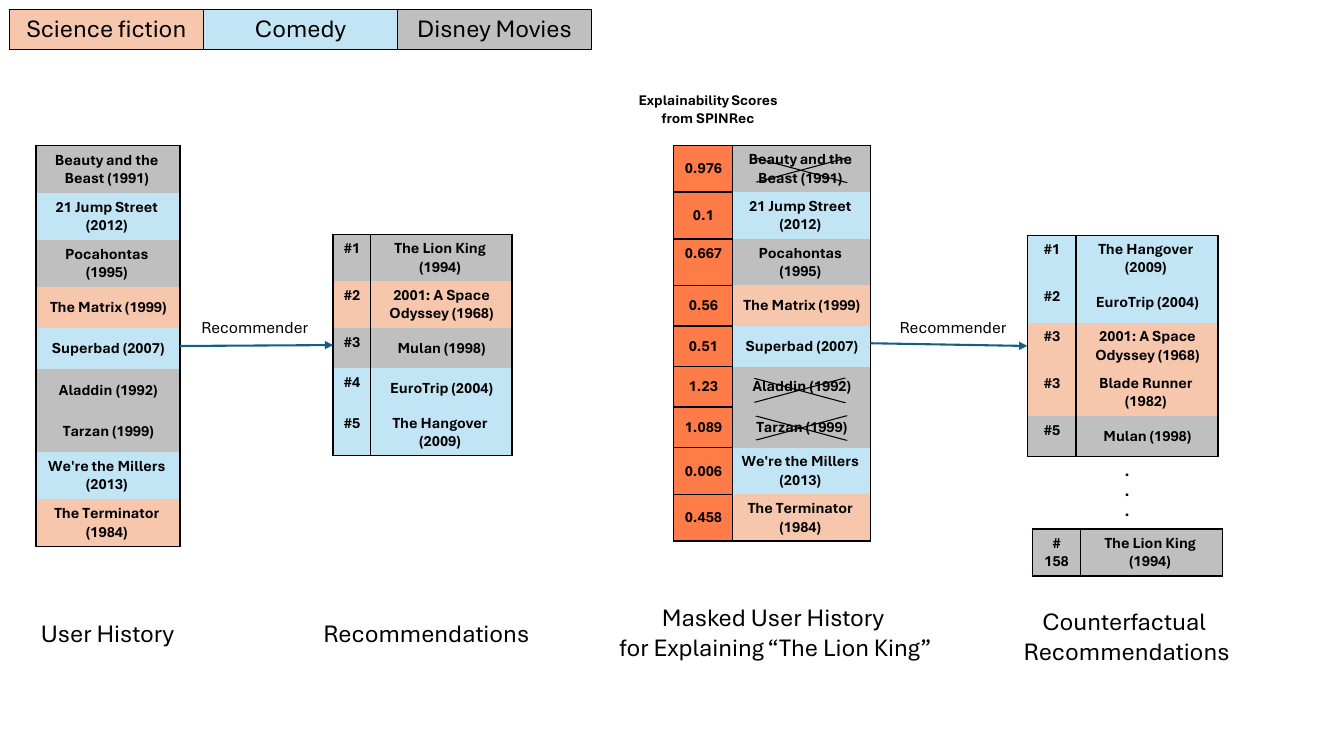Command Palette
Search for a command to run...
Oren Barkan Yahlly Schein Yehonatan Elisha Veronika Bogina Mikhail Baklanov Noam Koenigstein

초록
다음은 요청하신 기술 텍스트의 한국어 번역입니다. 학술적 전문성과 문맥의 정확성을 고려하여 번역하였습니다.설명 충실도(Explanation fidelity)는 설명이 모델의 실제 추론 과정을 얼마나 정확하게 반영하는지를 측정하는 지표로, 추천 시스템 분야에서는 여전히 충분히 탐구되지 않은 중요한 영역입니다. 본 연구에서는 희소(sparse)하고 암묵적(implicit)인 추천 데이터의 특성에 맞춰 경로 적분(path-integration) 기법을 적용한 모델 불가지론적(model-agnostic) 접근 방식인 SPINRec(Stochastic Path Integration for Neural Recommender Explanations)을 제안합니다.기존 방법론의 한계를 극복하기 위해 SPINRec은 확률적 베이스라인 샘플링(stochastic baseline sampling)을 도입했습니다. 이는 고정되거나 비현실적인 베이스라인에서 적분을 수행하는 대신, 경험적 데이터 분포에서 다수의 타당한 사용자 프로필을 샘플링하고 가장 충실도 높은 기여 경로(attribution path)를 선택하는 방식입니다. 이러한 설계는 관측된 상호작용뿐만 아니라 관측되지 않은 상호작용의 영향까지 포착하여, 보다 안정적이고 개인화된 설명을 제공합니다.당사는 세 가지 모델(MF, VAE, NCF)과 세 가지 데이터셋(ML1M, Yahoo! Music, Pinterest)을 대상으로, AUC 기반 섭동 곡선(perturbation curves) 및 고정 길이 진단(fixed-length diagnostics)을 포함한 일련의 반사실적(counterfactual) 지표를 활용하여 현재까지 가장 포괄적인 충실도 평가를 수행했습니다. 실험 결과, SPINRec은 모든 베이스라인 모델보다 일관되게 우수한 성능을 보였으며, 추천 시스템의 충실한 설명 가능성(faithful explainability)에 대한 새로운 벤치마크를 수립했습니다. 관련 코드와 평가 도구는 https://github.com/DeltaLabTLV/SPINRec 에서 확인하실 수 있습니다.
Summarization
Researchers from The Open University of Israel and Tel Aviv University introduce SPINRec, a model-agnostic framework that enhances explanation fidelity in recommender systems by employing stochastic baseline sampling to integrate attribution paths from plausible user profiles rather than relying on fixed or unrealistic baselines.
Introduction
As recommender systems increasingly shape user decisions in e-commerce and media, the demand for transparency has shifted focus from simple persuasiveness to fidelity, ensuring that explanations accurately reflect the model's actual decision-making process. However, applying established attribution techniques like Path-Integration (PI) to this domain is challenging because recommendation data is inherently sparse and binary. Standard PI methods, which rely on "all-zero" baselines, fail to capture the nuance of user interactions in this setting, often resulting in weak or misleading attribution signals.
To address this gap, the authors introduce SPINRec (Stochastic Path Integration for Neural Recommender Explanations), a novel framework that adapts Path-Integration specifically for neural recommenders. By moving away from static baselines, the authors provide a method that respects the unique data structure of recommendation engines.
Key innovations and advantages include:
- Stochastic Baseline Sampling: Instead of relying on an unrealistic all-zero baseline, the model samples multiple plausible user histories from the empirical data distribution to generate more stable and informative gradient signals.
- Domain-Specific Adaptation: The framework is the first to successfully adapt Path-Integration from computer vision and NLP to recommender systems, specifically addressing the challenges of high-dimensional, sparse, and binary data.
- Superior Fidelity: Extensive evaluations across multiple architectures (including Matrix Factorization and VAEs) and datasets establish SPINRec as the new state-of-the-art benchmark for counterfactual explanation fidelity.
Dataset
The authors conduct experiments using three distinct datasets: ML1M (MovieLens), Yahoo! Music, and Pinterest. The data preparation and evaluation strategy involve the following steps:
- Data Processing: All datasets are binarized to convert interactions into implicit feedback.
- Splitting Strategy: The researchers apply an 80/20 user-based split to divide the data into training and testing sets.
- Validation: An additional 10% of users are withheld from the training data to serve as a validation set for hyperparameter tuning.
- Evaluation Scope: Results are reported on the test set, with explanations specifically targeting the top recommendation for each user.
Method
The authors leverage path-integration methods to develop SPINRec, a framework for generating explanations in recommender systems. The core approach computes feature attributions by integrating gradients along a path from a baseline user representation to the actual user data. Given a user's binary feature vector x and a target item y, the predicted affinity fθy(x) is decomposed into contributions from individual features using a straight-line path r(t)=t⋅x+(1−t)⋅z, where z is a baseline vector and t∈[0,1]. The attribution for each feature is derived from the integral of the gradient of the model's output with respect to the interpolated input, weighted by the path's derivative. This results in an explanation map m, which quantifies the relevance of each feature to the recommendation, as defined in Equation \ref{eq:expl_map}.

Experiment
- The study evaluates the counterfactual fidelity of SPINRec across three datasets (ML1M, Yahoo! Music, Pinterest) and three recommender architectures (Matrix Factorization, VAE, NCF), comparing it against state-of-the-art baselines including LXR, FIA, and SHAP.
- On AUC-based fidelity metrics, SPINRec achieved the best results across all models and datasets, statistically surpassing strong baselines like LXR and FIA (p≤0.01).
- In fixed-length metric evaluations (POS, DEL, INS, CDCG), the method consistently outperformed all baselines across varying explanation lengths (Ke) and ranking cutoffs (Kr), demonstrating robustness in identifying high-impact features.
- Ablation studies validated the contribution of stochastic baseline sampling, showing that SPINRec significantly outperforms plain path integration (PI) by leveraging unobserved interactions, with performance gains most pronounced in complex models like VAE and NCF.
The authors use counterfactual fidelity metrics to evaluate explanation methods across multiple recommendation models and datasets, with results showing that SPINRec consistently outperforms all baselines in both AUC-based and fixed-length metrics. Across all configurations, SPINRec achieves the best performance, particularly in metrics like POS@K and CDCG, demonstrating superior fidelity in explaining recommendation outcomes.

The authors use counterfactual fidelity metrics to evaluate explanation methods across multiple recommendation models and datasets, with results showing that SPINRec consistently outperforms all baselines in both AUC-based and fixed-length metrics. Across all configurations, SPINRec achieves the best performance, particularly excelling in metrics like POS@K and CDCG, while also demonstrating robustness across different recommendation architectures and datasets.
